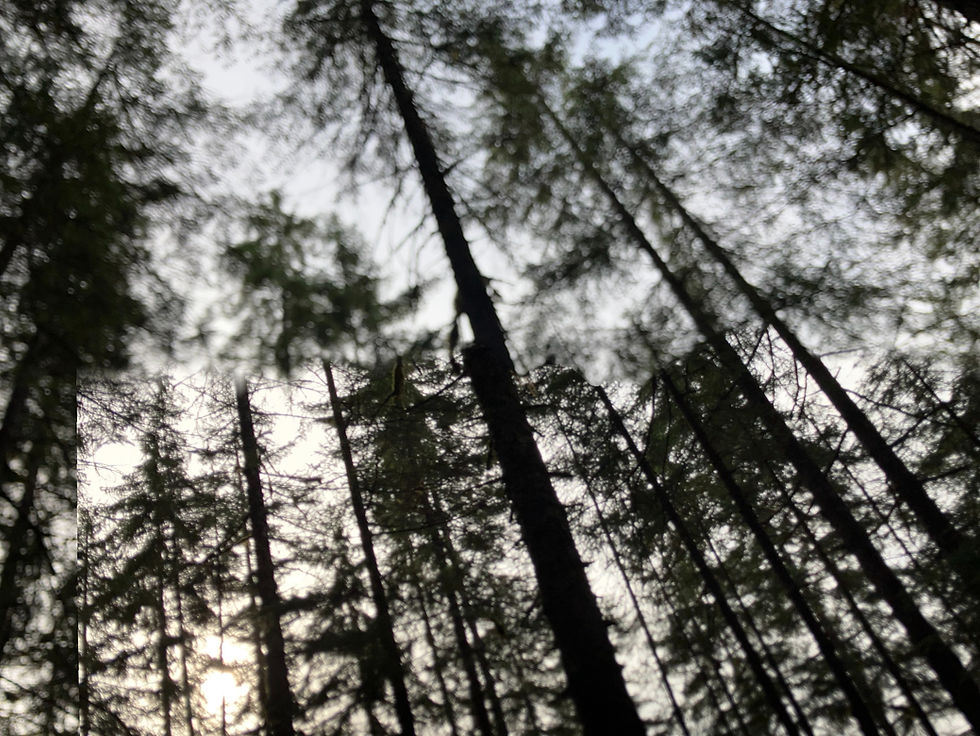Days 7 and 8 - Fields to Forests
- stellahdawson
- Apr 8, 2024
- 3 min read

The stubbly cornfields go on for miles and miles. Enter Canada. Saskatchewan, Land of the Living Skies it calls itself. Flat, windswept and monotone. It is unrelenting. Only here oil derricks interrupt the khaki-colored landscape, the corn gives way to wheat and there are open-pit mines. Coal, silver, potash. Everything is big. On the radio, they call it Big Country and play country music. The grain storage silos are huge, multiples all in a row. The railway stops are called Inland Terminals, where skyscraper-tall contraptions transfer grain into cargo cars. And the cargo cars on the trains go on and on and on, carrying away all that is extracted from this endless land. How much can we take out? How much do we eat that we need so much grain? How much we depend on this endless land I’ve never seen before that goes on and on for days. Everything is astonishingly expansive and colorless here.

I have been driving for five days through this landscape. It changes little. Straw stubbles turns to pale stubble. Gospel radio turns country music. Anti-abortion billboards turn to ads for engineering jobs in the oilfields. In the United States, the small farm towns in Minnesota looked prosperous. Here in Canada, they are dusty way stations on the highway, a gas station-come-grocery shop run by a recent immigrant who speaks halting English, a liquor store, dirt streets, low-slung ranch homes, four or five pick-up trucks or cars outside each house. The larger towns are larger versions, drive-through places with wide streets for big pickup trucks, big neon signs, long strips of long stores, fast food and gas stations – extract what you need and move on type of places. The women are friendly and say, “Oh wow!” when I tell them where I’m going. The men are big and burly and all wear baseball caps.
Some towns have a Pioneer Village, all pretty much the same: a wagon, wooden one-room cabins, maybe a sheriff’s office and maybe a stagecoach. But it’s the deserted farmhouses I find most poignant. You can spot them from the road by the cluster of trees that rise like an island from the endless sea of stubble, trees planted to protect the farming family from the relentless winds when they returned from the fields they wrestled out of the prairie. The utter determination of their task and the loneliness of it astonishes me, and now these proud, tall, timber homes they built through sheer willpower are tumbling down, red barns peeling, rooves caving in. The shiny corporate tractors, weeders, tillers, fertilizers, waterers and all the giant machinery of modern agriculture have done them in.
North of Edmonton, the fields give way to forests of spruce and birch. I am apprehensive of these forests I don’t know them, fearful of moose, elk, porcupine, coyote, wolves. They warn you to watch out for moose on the road. I leash Eiger when I walk him along forest roads that stretch as continuously as the fields once stretched that I now miss. I resolve to buy bear spray tomorrow. It's new territory.
Travel notes:
Friday, April 5 - Alexandria, Minnesota, to Minot, North Dakota
Saturday, April 6 - Minot, NID, cross the border into Canada, to Regina, Saskatchewan
Sunday, April 7 - Regine to Lloydminster on the border of Alberta
Monday, April 8 - Lloydminster to Grand Prairie, Alberta
Other sights: Raven and coyote eating carcass beside highway.
Thousands of snow geese migrating north to the Arctic Circle
Rivers and lakes are iced up still, but snow melted
Snowshoe hare





Wow! Five days of sameness. That's tough driving. Looking forward to hearing more about the forests.